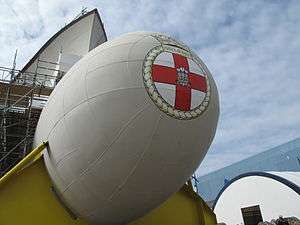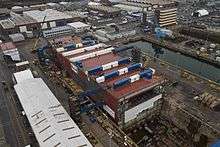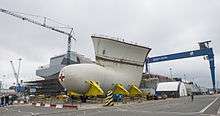HMS Prince of Wales (R09)
 Bow bulb of HMS Prince of Wales at Rosyth, May 2014 | |
| History | |
|---|---|
| Name: | HMS Prince of Wales |
| Namesake: | Prince of Wales |
| Ordered: | 20 May 2008 |
| Builder: | |
| Laid down: | 26 May 2011[1] |
| Launched: | 2017 (planned) |
| Commissioned: | 2020[2] (planned) |
| Homeport: | HMNB Portsmouth |
| Identification: |
|
| Motto: | Ich Dien ("I Serve") |
| Status: | Under Construction[3] |
| Badge: |
|
| General characteristics | |
| Class and type: | Queen Elizabeth-class aircraft carrier |
| Displacement: | 70,600 tonnes (69,500 long tons; 77,800 short tons)[4][5][6] |
| Length: | 280 m (920 ft)[7] |
| Beam: |
|
| Draught: | 11 metres[8] |
| Decks: | 16,000 square metres |
| Speed: | 25 knots (46 km/h) |
| Range: | 10,000 nautical miles (19,000 km) |
| Capacity: | 1,600 |
| Troops: | 250 |
| Complement: | 679 |
| Sensors and processing systems: |
|
| Armament: |
|
| Aircraft carried: |
|
| Aviation facilities: | Hangar below deck and two aircraft lifts. |
HMS Prince of Wales is the second Queen Elizabeth-class aircraft carrier under construction for the Royal Navy, with plans for active service from 2020. She is the eighth Royal Navy ship to have the name HMS Prince of Wales. Construction of the ship began in 2011 at Rosyth Dockyard and, as of April 2016, is said to be around 80% structurally complete.[11]
Unlike most large aircraft carriers, Prince of Wales is not fitted with catapults and arrestor wires and is instead designed to operate V/STOL aircraft; the ship will carry up to 40 F-35B Lightning II stealth multirole fighters and Merlin helicopters for airborne early warning and anti-submarine warfare. The design emphasises flexibility, with accommodation for 250 Royal Marines and the ability to support them with attack helicopters and troop transports up to and larger than Chinook size.[12]
In 2010, the British government announced that Prince of Wales would be either sold or mothballed due to budget cuts. However, in 2014, during the 2014 NATO Summit in Wales, Prime Minister David Cameron announced that the aircraft carrier would be brought into active service.[13] This commitment was later reaffirmed in the government's Strategic Defence and Security Review 2015 which was published in November 2015.[14]
Prince of Wales is set to be handed over to the Royal Navy in 2019, and be fully ready for front-line duties around the globe from 2023.[15]
Design and construction


The ship is identical in design to its sister ship and first-of-class HMS Queen Elizabeth (R08).
The original 2008 design envisaged flying F-35B Lightning II Short Take-Off and Vertical Landing (STOVL) jets from a ski-jump ramp. However, in May 2010, the government decided it would acquire the Catapult Assisted Take-Off But Arrested Recovery (CATOBAR) variant, the F-35C, and convert Prince of Wales to a CATOBAR configuration.
In May 2012, following a rise in costs associated with the CATOBAR conversion, the government announced that it would revert to its original plans of acquiring the F-35B variant and building Prince of Wales to its original STOVL configuration.[16]
Entry into service
In May 2010, the Strategic Defence and Security Review (SDSR) declared that the UK required only one aircraft carrier, but penalty clauses in the contract meant that cancelling the second aircraft carrier, Prince of Wales, would be more expensive than building it. The SDSR therefore directed that Prince of Wales would be built and then either mothballed or sold.[17]
In 2012, contrary to the decisions made in the SDSR, the Royal Navy published its yearbook, A Global Force 2012/13, which stated that: "both carriers are likely to be commissioned and may even be capable of operating together".[18]
During the 2014 NATO Summit in Wales, Prime Minister David Cameron announced that Prince of Wales would be brought into active service, rather than be sold off or mothballed.[13] This was later confirmed in the government's 2015 Strategic Defence and Security Review.[14]
Prince of Wales is currently being assembled at Rosyth from 52 blocks built by six shipyards around the UK. Construction began on 26 May 2011, with the first steel being cut at Govan shipyard by Dr Liam Fox.[1] As of April 2016, the ship is said to be around 80% structurally complete.[11]
Under current plans, Prince of Wales will be commissioned in 2020.[2]
Armament and aircraft
The Queen Elizabeth class can carry up to 40 Lockheed Martin F-35B Lightning II multirole stealth fighters, but a more routine air wing will consist of 12–24 F-35B and a helicopter group of anti-submarine AW101 Merlins and troop transport helicopters.
Name

The Queen Elizabeth-class carrier will be the eighth HMS Prince of Wales, named after the title traditionally granted to the heir apparent of the British monarch. The name was announced at the same time as sister ship Queen Elizabeth. Controversy over the decommissioning of HMS Ark Royal under the terms of the SDSR in 2010, and the subsequent loss of the name Ark Royal led to a campaign for one of the new aircraft carriers to receive it. In May 2011, reports surfaced that HRH The Prince of Wales had been approached by a senior Royal Navy officer on the subject of changing the name of Prince of Wales to Ark Royal, a matter that the Prince of Wales was reportedly "pretty relaxed" about.[19]
Affiliations
- Bristol
- Liverpool
- Worshipful Company of Goldsmiths
- Welsh Guards
- The Royal Lancers
- No. 27 Squadron RAF
See also
References
- 1 2 "Steel cut on second super-carrier". Navy News.
- 1 2 Maddox, David (23 March 2013). "600 Royal Navy personnel may be stationed at Rosyth". The Scotsman.
- ↑ "House of Commons Hansard Written Answers for 21 Nov 2011". HM Government. 21 November 2011. Retrieved 22 November 2011.
- ↑ Harris, Stephen (27 May 2014). "Your questions answered: HMS Queen Elizabeth aircraft carrier". The Engineer.
- ↑ "Progress being made but uncertainties remain", WarShip Technology: July/Aug 2013, The Royal Institution of Naval Architects
- ↑ "Queen Elizabeth class aircraft carrier: A Guide". UK Defence Journal. 3 April 2014. Retrieved 14 November 2014.
- ↑ "Queen Elizabeth Class". Royal Navy. Retrieved 21 August 2013.
- ↑ "Future Aircraft Carrier (CVF)". Ministry of Defence. Retrieved 21 May 2008.
- ↑ "Queen Elizabeth class: facts and figures". Royal Navy.
- ↑ "Fleet Air Arm: future aircraft". Royal Navy.
- 1 2 "Aircraft Carriers:Written question – 33852". HM Government. 20 April 2016. Retrieved 20 April 2016.
- 1 2 "UK aircraft carrier Prince of Wales to go into service". BBC News. 5 September 2014. Retrieved 5 September 2014.
- 1 2 "National Security Strategy and Strategic Defence and Security Review 2015" (PDF). HM Government.
- ↑ "Iconic structure is installed on HMS Prince of Wales".
- ↑ "Defence Secretary Announces Decision on Jets for Navy's Future Carriers". www.royalnavy.mod.uk. Royal Navy. 10 May 2012. Retrieved 10 May 2012.
- ↑ Securing Britain in an Age of Uncertainty: The Strategic Defence and Security Review (pdf), HM Government, October 2010, p. 23, ISBN 9780101794824
- ↑ "A Global Force 2012/13" (pdf). Royal Navy. 2013. p. 24. ISBN 978-1-906940-75-1.
- ↑ Harding, T (2 May 2011). "Prince Charles 'saves Ark Royal'". Daily Telegraph. Retrieved 10 May 2011.
External links
- Prince of Wales (royalnavy.mod.uk)